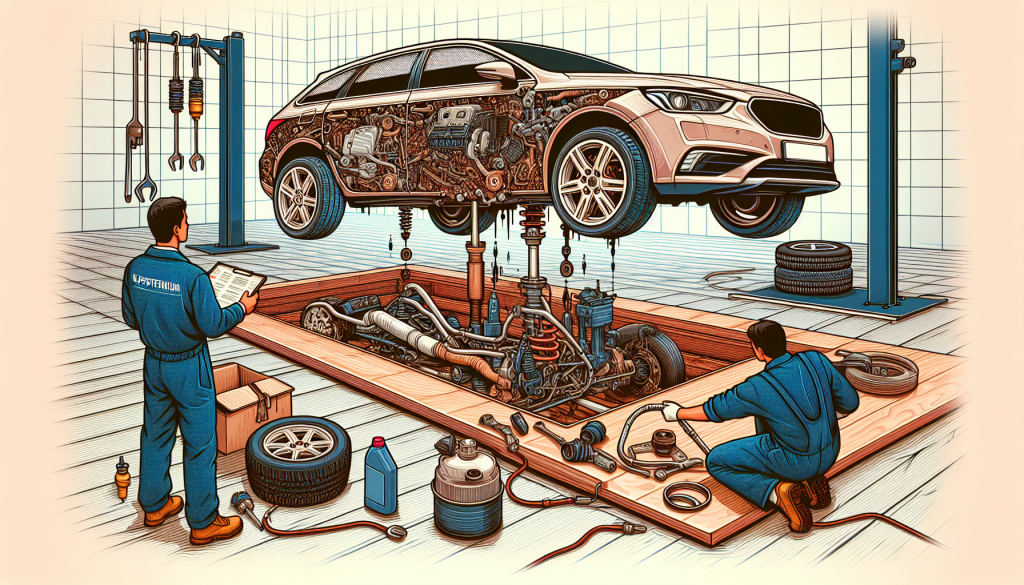Signs Your Suspension’s Acting Up
Spotting suspension problems early can save you from a bumpy ride and bigger headaches down the road. Here’s how to tell if your car’s suspension needs some TLC.
Tires Wearing Funny
If your tires look like they’ve been chewed on by a giant hamster, you’ve got suspension issues. Uneven tire wear is a dead giveaway. This can happen because of misalignment, tired shock absorbers, or busted suspension parts.
| Tire Wear Pattern | What’s Wrong |
|---|---|
| Inner or Outer Edge Wear | Misalignment |
| Cupping or Scalloping | Worn Shock Absorbers |
| Feathering | Worn Suspension Parts |
Keep an eye on those tire wear patterns. They’re like the footprints of your suspension’s health. For more on this, check out our article on tire wear patterns.
Car Pulling a Houdini
If your car’s trying to pull a disappearing act to the left or right, it’s probably a suspension problem. This usually means misalignment or uneven tire pressure. Misalignment can make your car drift, which is not just annoying but also dangerous.
| Symptom | What’s Up |
|---|---|
| Car Pulling Left or Right | Misalignment, Uneven Tire Pressure, Worn Suspension Parts |
If this happens, get a pro to check your wheel alignment. Learn more about the alignment process and why regular check-ups are a must for keeping your ride smooth.
Bouncing Around
Feeling like you’re on a pogo stick instead of driving? Excessive bouncing means your shocks or struts might be shot. This not only makes for an uncomfortable ride but can also mess with your car’s handling.
| Symptom | What’s Up |
|---|---|
| Excessive Bouncing | Worn Shocks or Struts |
Noisy Rides
Hear clunking, knocking, or squeaking when you hit a bump? That’s your suspension crying for help. These noises often come from worn or broken parts that need replacing.
| Symptom | What’s Up |
|---|---|
| Clunking or Knocking | Worn or Broken Suspension Parts |
Sagging Corners
If one corner of your car is sagging, it’s a sign of a broken spring or other suspension issues. This can affect your car’s balance and handling.
| Symptom | What’s Up |
|---|---|
| Sagging Corner | Broken Spring or Suspension Issues |
Steering Problems
If your steering feels loose or you have trouble keeping your car straight, your suspension might be to blame. This can be due to worn steering components or alignment issues.
| Symptom | What’s Up |
|---|---|
| Loose Steering | Worn Steering Components, Alignment Issues |
Conclusion
Don’t ignore these signs. Addressing them early can save you from bigger problems and keep your car safe and reliable. For more tips, check out our articles on suspension components and fixing suspension issues.
Fixing Suspension Problems
Keeping your car’s suspension in good shape is key to staying safe and enjoying a smooth ride. Regular check-ups and expert help can catch problems early before they turn into big headaches.
Why Regular Suspension Check-Ups Matter
Getting your suspension checked regularly is like going to the dentist—catching small issues before they become big ones. These check-ups can save you from costly repairs and keep your ride smooth. During these visits, mechanics look at parts like shocks, struts, and control arms to spot any wear and tear.
| How Often | What to Do |
|---|---|
| Every 6 months | Quick visual check |
| Every 12 months | Full inspection of all suspension parts |
| Before long trips | Thorough check-up |
Regular check-ups also help you keep an eye on your tires. Uneven tire wear can be a sign that something’s up with your suspension. Fixing these issues early can save you money on new tires and keep your car running longer.
Getting Your Wheels Aligned by Pros
Getting your wheels aligned by a professional is crucial for keeping your car running smoothly. This service involves tweaking the angles of your wheels to make sure they’re perfectly aligned with your car’s frame.
During an alignment, mechanics use precise tools to adjust the camber, caster, and toe angles of your wheels. This fine-tuning helps your car handle better and reduces tire wear.
| Angle | What It Is | Why It Matters |
|---|---|---|
| Camber | Tilt of the wheel | Boosts stability and handling |
| Caster | Angle of the steering pivot | Improves steering control |
| Toe | How the wheels line up with each other | Cuts down on tire wear |
After the alignment, a road test ensures everything’s set up right. Regular alignments are especially important when you get new tires or after fixing suspension parts. For more details, check out our guide on the alignment process.
Trained mechanics using the latest tools can give you accurate and reliable alignments. It’s also good for car owners to know why regular alignments matter and how they keep your car in top shape. For tips on seasonal adjustments, read our article on seasonal suspension alignment adjustments.
By keeping up with regular check-ups and professional alignments, you can nip suspension problems in the bud and keep your car running smoothly and safely.



